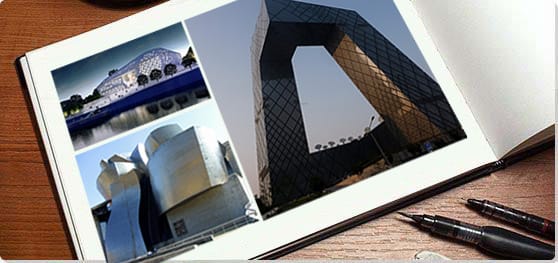Summary of Deconstructivism and Architecture
Completely capsizing the modernist orthodoxy that "form follows function", the Deconstructivists blazed a brand-new movement; one shaped by an energy and vitality that would come to define the cutting-edge in late-20th - early-21st century architectural design. The idea of deconstructing artworks had been a well-established postmodern practice since the 1960s. But whereas postmodernism was intent on "reinventing" or "playing with" the past (often through the concepts of irony and pastiche), the Deconstructivists (named as such despite their conspicuous lack of uniformity in style) pursued a wholly contemporary vision based on creating fully functional buildings matched to spectacular asymmetrical exteriors. Moving into the 21st century, Deconstructivism evolved to embrace the idea of Parametricism, a term that accounted for the use of the most advanced computer technology that opened the door to even greater possibilities in asymmetrical, curvilinear, design.
Key Ideas & Accomplishments
- Deconstructivism stems directly from the theoretical writings of the Algerian-French philosopher Jacques Derrida. He sought to dismantle the time-honored hierarchal ordering of the architectural world around binary oppositions such as Classicism versus Modernism, function over form, and interior versus exterior. Deconstructivists translated Derrida's ideas by calling into question the clean geometric lines of modernism in favor of designs that embraced fragmentation and invoked movement. Derrida himself collaborated with Peter Eisenman on the design for a garden section at Tschumi's Parc de la Villette (but that was never realized).
- The birth of the movement was signaled by the Deconstructivist Architecture exhibition at New York's Museum of Modern Art in 1988. Philip Johnson and Mark Wigley brought together seven relatively unknown architects whose work showed, in Johnson's words, "a similar approach with very similar forms as an outcome". Despite the declaration of Johnson that Deconstructivist architecture "represents no movement; it has no creed", the term stuck with some of its practitioners, notably Zaha Hadid, Frank Gehry and Rem Koolhaas - who all rose to the ranks of architectural superstars, the so-called "starchitects".
- Deconstructivist façades are associated with the concept of "follies". Originally, follies were ornamental features for gardens, estates, and public parks dating back to the 16th century that served as social gathering points. They were fake ornamental structures that copied such things as classical temples and towers, Egyptian pyramids, and even ancient ruins. For Deconstructivists, the concept of follies applies to their preference for flamboyant abstract façades that designated a place for important social gatherings and cultural interactions.
- Although Deconstructivists reject modernist dogmas, they did draw inspiration from the Russian Constructivist movement (originating around 1915). The Constructivists were committed to establishing a post-revolutionary society founded on the idea of overturning traditional perception of architecture and to open the Soviet people's eyes to the progressive possibilities of breaking architecture rules. And like the Constructivists, the Deconstructivists were dedicated to experimenting with irregular geometric patterns and perspectives.
Overview of Deconstructivism and Architecture
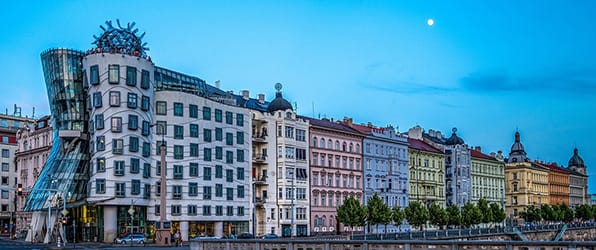
Architect and writer, Mark Wigley, wrote, "Deconstruction gains all its force by challenging the very values of harmony, unity, and stability, and proposing instead a very different view of structure: the view that the flaws are intrinsic to structure. A deconstructive architect is therefore not one who dismantles buildings, but one who locates the inherent dilemmas within buildings".
Artworks and Artists of Deconstructivism and Architecture
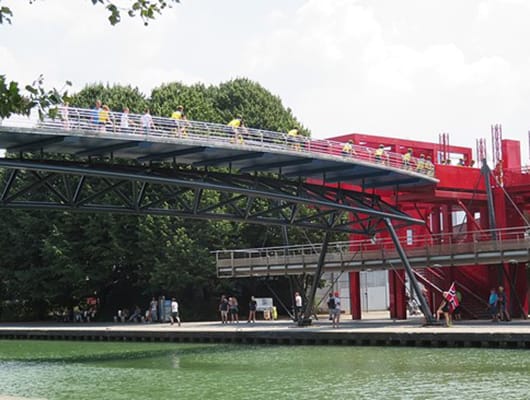
Parc de la Villette
In 1982, François Mitterrand, the then-president of France, invited architects to submit designs for a plot of land (it had been a slaughterhouse during the rule of Napoleon III) that he envisioned as an "urban park of the 21st century". A total of 470 architects entered submissions, including Deconstructivist pioneers Rem Koolhaas and Zaha Hadid. But it was Swiss architect Bernard Tschumi's design that triumphed. Tschumi's vision, realized with the help of architect Colin Fournier, was for a park that enabled new forms of social and cultural engagements, and chance interactions, across the park's 55 hectares. He accomplished his goal by designing the space around the concept of architectural "follies" (in French, an act of "madness" or "irrationality"; or in English act of "being foolish").
The idea of architectural follies dates back to 16th century Europe. Follies adorned the gardens and grounds of the landed aristocracy, and later, became a feature in some public parks. These constructions (made of stone, wood, and/or brick) were small-scale facsimiles of classical temples; gothic towers; Egyptian pyramids, abbeys, ancient ruins, and the like. Follies served more than an ornamental function, however. They were landmarks that also indicated social meeting points and even doubled as venues for religious ceremonies (such as marriages). The Parc de la Villette's 35 "follies" did not parody the architecture of the past. Rather, Tschumi took the basic concept of follies to create social hubs - play areas; cafés; a cinema; a concert hall; and other general meeting points - that also acted as signposts that allowed for the park's interlocking square grid of pathways to be easily navigated by the public.
The Parc de la Villette, which was unveiled over a period of 11 years, facilitated new possibilities for urban social connections within built environments. Tschumi himself stated that the park should be understood as "one of the largest buildings ever constructed - a discontinuous building but a single structure nevertheless". Thus, rather than create a design that mirrored the natural landscape of the park's grounds, Tschumi envisioned an artificial network that offsets the urban surroundings. However, Tschumi was careful not to overdetermine the intended use of the designed space. The concept of the park relies on the engagement, whims, and interchanges of the visitor. As Tschumi writes in his book on the project, the park is a design that "can be seen to encourage conflict over synthesis, fragmentation over unity, madness and play over careful management".
Architectural critic, Owen Hopkins, writes, "In retrospect, Tschumi's 1982-83 competition-winning scheme for the Parc de La Villette in Paris is the defining deconstructivist project. Rejecting the age-old opposition between park and city, and beyond that between culture and nature itself, Tschumi conceived three ordering systems which he superimposed onto the site to generate a series of gardens, galleries, and red steel follies. The latter looked like a cross between constructivist agitprop structures and Anthony Caro sculptures - mash-ups of familiar architectural forms yet with no fixed referents". Considered one of the first examples of Deconstructivist design, the park was featured in the famous Deconstructivist Architecture exhibition of 1988 and, like Frank Gehry's Santa Monica Residence (also featured), is cited as a "turning-point" in avant-garde architectural innovation.
Paris, France
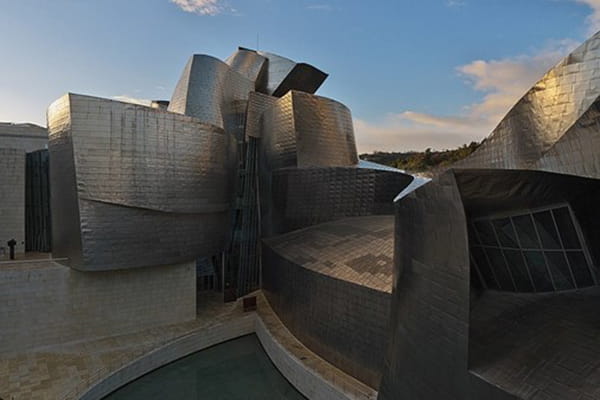
Guggenheim Museum Bilbao
Frank Gehry is a major figure in the Deconstructivist movement. His design for the Guggenheim Museum of Art in Bilbao, in the Basque region of Spain, is perhaps his most iconic building. The museum, which welcomes hundreds of thousands of visitors each year, boasts 120,000 square feet of exhibition space, spread over nineteen galleries. It sits atop the Nevrión River in Bilbao's old industrial city center. The striking curves of the exterior walls, constructed of titanium, glass, and limestone, are, according to Gehry, "designed to catch the light" and, in their haphazardness, mimic the rolling hills of the surrounding landscape. Although the structure interacts with nature and natural light, the iridescent facade is unabashedly synthetic.
The Bilbao Guggenheim stands as a definitive example of Deconstructivism: its asymmetry, distorted façade, and chaotic composition are all signifiers of the architectural style and recalls early 20th century Cubist and Constructivist movements (both of which had explored the manipulation of perspective through irregular geometrical abstraction). In order to achieve the bowed and twisted effect of the museum's façade, Gehry turned to a software called CATIA, which was originally built for aircraft design. As architectural critic Rowan More writes, after Gehry's Bilbao feat "The ability of computers to design unfeasibly elaborate buildings has since multiplied".
The Solomon R. Guggenheim Foundation declares on its website that "The Guggenheim Museum Bilbao is a pinnacle in Gehry's outstanding architectural career as well as in the field of museum design. It remains unsurpassed in its integration of art and architecture, maintaining an aesthetic and programmatic unity". This "selling point" was picked up on by architecture critic Rowan Moore who wrote (to mark the occasion of the museum's 20th anniversary), "An agreement was worked out, an early instance of the international trading of museum brands that also engenders, for example, the forthcoming Louvre Abu Dhabi, whereby the governments of the city, and of the province and region in which Bilbao stands, would pay for construction, and contribute to acquisitions and running costs. The Guggenheim Foundation would lend its name, works from its permanent collections and its management and curatorship. The arrangement wasn't universally popular - it was called 'McGuggenheim' [a blunt reference to the McDonald's fast food chain], an act of cultural imperialism paid for by the people it subjected - but it gave Bilbao access to the high-quality art without which a museum would be pointless".
Bilbao, Spain
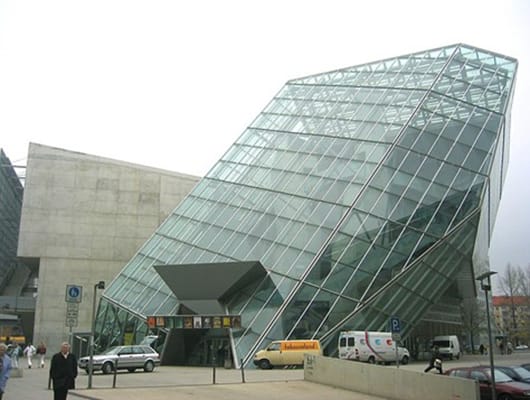
UFA Cinema Center
Coop Himmelb(l)au (the name given to an architecture, urban planning, design, and art firm founded in Vienna by Wolf D. Prix, Helmut Swiczinsky and Michael Holzer in 1968) designed the UFA Cinema Center with the vision of bringing an intriguing, angular, and innovative engineering feat to downtown Dresden, Germany. The firm's design for the theater is composed of two distinct "blocks". The Cinema Block houses eight theaters and seats 2600 guests. Its angular façade is built with exposed concrete, with its exterior network of stairwells and passageways jutting outward into the surrounding urban space. The transparent, polygonal (a plane with at least three straight sides and angles, but usually with five or more) glass structure slopes in the opposite direction. Free-standing staircases, bridges, and paths are visible (through the glass) from outside the structure. This section of the building serves as the foyer for the adjoining Cinema Block, but it also serves a much more unique function. Himmelb(l)lau envisioned this space as an urban transportation route, at once removed from, and a part of, the surrounding streets. Pedestrians are able to enter the glass shell and traverse its network of pathways. The passageways that surround the Cinema Block are also permeable for pedestrian traffic.
Himmelb(l)au's concept for the UFA addresses the problem of urban space in Dresden. As the architectural firm's website explains, "the content of the building becomes visible to the city as much as the city is visible from the building. It is an inside-out building which sustains a dialogue with the city". In this way, the cultural center resists the tide of urban development that results in privatized, unusable space and buildings intended only for residents, paying visitors, or employees. In the UFA Cinema Center, public engagement is at the forefront of the design philosophy. In addition to its role as an urban solution, the UFA also engages with the developing theories of Deconstructivist architecture. The building is intentionally startling and, rather than composing legible geometries, Himmelb(l)au constructs a mélange of abstract and discrete fragments. Scholar Pawel Rubinowicz writes, "This structure is 'non-geometric.' It makes the impression of random composition of different forms. The final effect may shock and delight as well".
Dresden, Germany
Memorial Square World Trade Center
Many Deconstructivist proposals were never realized due to factors such as budget constraints, public disapproval, and failures to land open-submission design competitions. Despite their lack of to-scale realization, some Deconstructivist architectural plans are useful in illustrating the movement's more conceptual roots. One such example is Peter Eisenman's design for a Memorial Square at the site of the former World Trade Center (destroyed in the 2001 terrorist atrocity). With the help of associates, Eisenman proposed a structure that would stand proudly on New York City's skyline while acting as a mechanism for "symbolizing its connections to the community, the city, and the world".
Of all the Deconstructivist architects, Eisenman is perhaps the most closely aligned the conceptual aspects of Deconstructivism and Derrida's theoretical ideas (he even worked with the philosopher to develop an entry for the competition to design Paris's Park de la Villette before losing out to Bernard Tschumi's entry). Eisenman's memorial design brought together a new skyscraper complex, a transit hub (connecting routes between the surrounding monuments and buildings, the Hudson River, and Lower Manhattan), and stairways leading to an underground retail concourse and a Subway terminal. And while Eisenman's design lost out to Daniel Libeskind (whose plan included six new skyscrapers and a memorial and museum dedicated to the 2,700 killed in the attacks), his proposal still stands as a fine example of how he sought to "deconstruct" the conventions of city planning, skyscraper design, and the interplay of architecture and its surrounding environment.
Eisenman's design reflects his fascination with the idea of "cognitive voids" (as fully realized three years later in the architect's Memorial to the Murdered Jews of Europe, in Berlin). In Deconstructivist architecture, voids carry both functional and cognitive qualities. While the former accounts for open spaces such as courtyards, galleries and terraces, cognitive voids bring a conceptual element into play via purely visual and perceptual design effects. His preference for cognitive voids was made abundantly clear in his final design proposal: "The most visible sign of the site's renewal is the proposed hybrid buildings, which rise 1,111 feet to restore the New York skyline with geometric clarity and an image of dignity and calm. Composed of five vertical sections and interconnecting horizontal bars, each three floors deep, the two mixed-use buildings represent a new typology in skyscraper design. At grade, their forms become ceremonial gateways into the site. In their abstraction of solids and voids, the buildings seem like screens, suggesting both presence and absence, and inspiring reflection and imagination. Their cantilevered ends extend outward, like the fingers of the ground plan, reaching toward the City and each other. Nearly touching at the northeast corner of the site, they resemble the interlaced fingers of protective hands".
New York City, New York (not built)
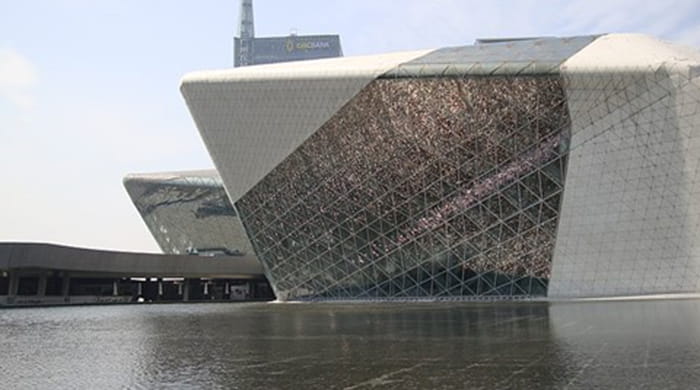
Guangzhou Opera House
Zaha Hadid's design for the Guangzhou Opera House in Guangzhou, China offers visitors a far more immersive aesthetic experience than the typical "night at the opera". Its smooth, dual-part structure made of glass, concrete, granite, and steel juts out onto Guangzhou's Pearl River, seamlessly integrating the skyline of the overcrowded metropolis with the landscape's natural features. Hadid's internationally acclaimed designs are renowned for exactly that sensibility: the architect routinely uses natural light and smooth, curving forms to create structures that are at once highly contemporary and unified with the natural world. The resulting creations are dreamlike, futuristic, and dynamic.
Hadid designed the bipartite structure of the Opera House to resemble two pebbles washed ashore by the Pearl River's tide. The interior of the building also champions the principles of integration of city and nature: the design ensures that light cuts deeply into the structure, and the rolling internal curves recall the fluidity of the natural world. Similarly, the hundreds of tiny lights that cover the ceiling of the auditorium resemble a celestial skyscape. With this "architectural wonder" (adding to her already impressive list of architectural achievements) Hadid's presents a unique interpretation of the Deconstructivist style without erring from the principles of irregular geometric line and derivations from modernist symmetry.
Hopkins writes, 'For young and aspiring architects looking for alternatives to modernism, but put off by postmodernism's perceived trivialities, constructivism [with its emphasis on experimentation, and its assault on existing architecture norms] was a revelation and it quickly became important in architecture schools, notably the Architecture Association in London under Alvin Boyarsky's direction, where several of the Deconstructivist architects studied and taught in the late 1970s. Of them, Zaha Hadid, was the one who most fully embraced constructivism as the basis for her own, highly distinctive formal language".
Guangzhou, China
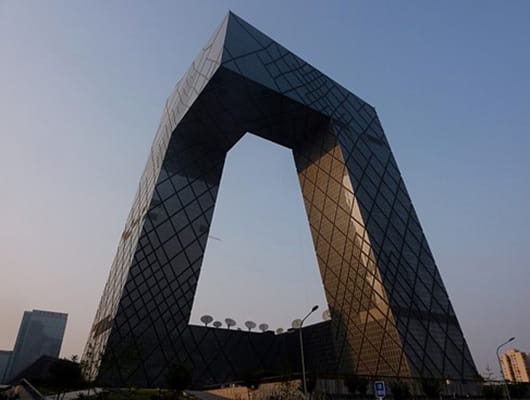
CCTV Headquarters
By the time Rem Koolhaas was commissioned to design the CCTV building, he had established himself as a major thinker, writer, and designer of the Deconstructivist movement. With his firm, OMA Architects, Koolhaas envisioned the building as a way of "conceptualizing, liberating and realizing structure that did not exist in China before". His buildings differ vastly in appearance from one design to the next, but are united in their commitment to innovation, geometric exploration, and the use of cutting-edge technology. True to Koolhaas's drive to challenge expectation in architecture, the CCTV building's peculiar design consists of two towers that lean against one another and which are conjoined by a central wing. At 768 feet tall, and 51 floors, the CCTV Headquarters has become a major feature of Beijing's skyline.
Due to its unusual appearance and imposing size (it was nicknamed "big pants"), the building received a mixed reception from locals and critics. As Nicolai Ouroussoff wrote in the New York Times, "Koolhaas represses all the most obvious signs of human scale, like the repetitive windows and floor slabs of a conventional tower. From a distance it's virtually impossible to get a grip on the building's size - an apt metaphor for the way giant media companies like CCTV have collapsed the scale of our world". Despite its uneven reception, Koolhaas's CCTV building is an icon of late Deconstructivist architecture. The impressive specificities of this accomplishment are not limited to the exterior appearance of the building: Koolhaas employed a mechanism called "cross-programming" in which he integrated routes through the building along which the general public can travel. In this way, the architect invites public participation into a corporate environment (recalling Coop Himmelb(l)au's permeable UFA Cinema Center and Peter Eisenman's proposed Memorial Square at the World Trade Center).
Architectural critic Nicolai Ouroussoff said of Koolhaas, "Architects dig through his books looking for ideas; students all over the world emulate him. The attraction lies, in part, in his ability to keep us off balance. Unlike other architects of his stature, such as Frank Gehry or Zaha Hadid, who have continued to refine their singular aesthetic visions over long careers, Koolhaas works like a conceptual artist - able to draw on a seemingly endless reservoir of ideas".
Beijing, China
Beginnings of Deconstructivism and Architecture
Philosophical Origins
The concept of deconstruction in architecture derives from a complex philosophical concept. Deconstruction theory is associated with the 1960s writings of the Algerian-French linguist and philosopher Jacques Derrida and occupies (through writers such as Rosalind Krauss) a conspicuous place in art theory and criticism. The idea of "breaking down" a text/artwork to reveal a hidden meaning or agenda has long had a significant impact on the fields of literature, linguistics, psychoanalysis, LGBTQ studies, and art. Analysts have deconstructed deceptively benign examples from television commercials to cartoons, but in fine art the concept of deconstruction has tended to be absorbed into the bigger subject of postmodernism. However, in the field of architectural practice and theory, Deconstructivism moves beyond postmodernism to claim a more acutely defined position. It follows the principle of defying the expectation of traditional architectural forms and rethinking the possibilities of aesthetic creation in a way that embraces arbitrariness, asymmetry, contradiction, and fragmentation.
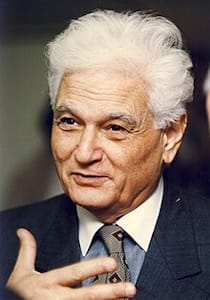
The architectural movement known as Deconstructivism ascends directly from the ideas of Derrida. His theory is based on the principle that Western thinking is organized according to hierarchical structures of language; what Derrida called "logocentrisms". He was opposed to ideas of "binary oppositions" within language, and where the opposing positions take on primary and secondary roles: nature/culture, speech/writing, mind/body, modernism/classicism, for example. For Derrida, différance (differences of meaning) suggests that even basic logical and ontological concepts lack certainty and stability. Derrida was thus resistant to claims to any sort of finite truth. The Deconstructivist translates these ideas into finding ways to work that bypass these oppositions. As the architectural historian, Dima Stouhi, writes, "Deconstructivism is, in fact, not a new architecture style, nor is it an avant-garde movement against architecture or society. It does not follow 'rules' or acquire specific aesthetics, nor is it a rebellion against a social dilemma. It is the unleashing of infinite possibilities of playing around with forms and volumes".
Rem Koolhaas and the Dawning of a New Movement
In 1975, the Dutch architect and urbanist, Rem Koolhaas, co-founded, with Elia and Zoe Zenghelis and Madelon Vriesendorp, the firm, Office of Metropolitan Architecture (OMA). During the 1960s he had been a member of a small group of Dutch Surrealist writers. "There were two kinds of '60s," he later said, "one was avant-garde, highly modernist - Antonioni, Yves Klein. The other was the Anglo-Saxon, hippie-ish, political side. I associated with the avant-garde tendency". The OMA submitted ingenious entries for architectural design competitions and, in 1978, Koolhaas followed with a book titled, Delirious New York: A Retroactive Manifesto for Manhattan. The book laid out the concepts for the utopian architectural aesthetic based on disjointed asymmetrical forms, and seemingly random volumes. These features would become defining characteristics of Deconstructivist architecture. But it would be another ten years before the term entered into common architectural phraseology.
Critics and historians are inclined to draw attention to the fact that Deconstructivism is a rather loose term given that it was first applied to a small group of architects who had not signed up to Koolhaas's manifesto, and who shared little by way of a unified artistic vision. In fact, the label was rather foisted on the initial seven "members" - Koolhaas, Coop Himmelb(l)au, Peter Eisenman, Frank Gehry, Zaha Hadid, Daniel Libeskind, and Bernard Tschumi - following their involvement in the Deconstructivist Architecture exhibition at New York's Museum of Modern Art in 1988. Curated by Mark Wigley and Philip Johnson (director of MoMA's Department of Architecture and Design), and with further assistance from Frederieke Taylor, the link between the designers was made by Johnson who wrote that the group had, like the Russian Constructivists of the early part of the 20th century (and whose designs were also represented at the exhibition), collectively abandoned "the traditional virtues of harmony, unity, and clarity", and replaced them with "disharmony, fracturing, and mystery". Despite being a rather limited exhibition (it took over just three galleries), it had sowed the seeds of a distinct Deconstructivist movement.
The Ascent of Deconstructivism
According to curator Tina di Carlo, Wigley and Johnson could be credited with "dramatizing the movement's rise as the most pervasive new direction in Western architecture since the Renaissance". However, in an interview (to publicize the Deconstructivist Architecture exhibition) Johnson maintained that Deconstructivism "did not represent any 'great messianic vision here or now' [while Wigley] cautioned that the exhibition was not an application of deconstructive theory; nor did it derive from the contemporary mode of philosophy known as 'deconstruction'". Those proclamations notwithstanding, di Carlo argues that it was "arguably Johnson's formal language and a highly constructed formal similarity between projects that became equated with an identifiable style". Even for sceptics, the exhibition had prompted debates about what constitutes "the limits of architecture" under the growing "awareness that the work looked strikingly different from what had come before".
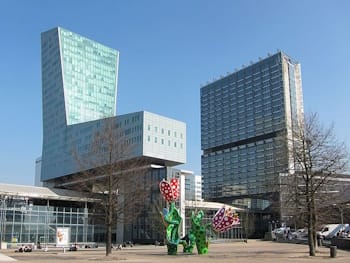
Between 1989-94, Koolhaas offered the first fully realized vision of Deconstructivism through his "urban masterplan" (covering more than 800,000 square meters) for the French city of Lille. As architectural critic Nicolai Ouroussoff describes, "Linked to a new high-speed rail line, the development, called Euralille, included a shopping mall, conference and exhibition center, and office towers surrounded by a tangle of freeways and train tracks. Seeking to give it the richness and complexity of an older city, Koolhaas envisioned a pileup of urban attractions. A concrete chasm, crisscrossed by bridges and escalators, would connect an underground parking garage to a new train station; a row of mismatched office towers would straddle the station's tracks. For added variety, celebrated architects [such as Christian de Portzamparc and Claude Vasconi] were brought in to design the various buildings; Koolhaas designed the convention hall".
Deconstructivism in the 1990s
Following the Deconstructivist Architecture exhibition, and Koolhaas's Lille project, the "new style" started to attract increased international attention. Even so, the architects associated with Deconstructivism still remained uncomfortable with the label. Tschumi voiced that hesitancy, insisting that "calling the work of these architects a 'movement' or a new 'style' was out of context and showed a lack of understanding to their ideas". Yet while it remained problematical to define precisely what set of aesthetic sensibilities Deconstructivism encapsulates, the associated architects did share a commitment to the rejection (ergo, deconstruction) of modernist rectilinear forms. Indeed, by the mid-to-late 1990s, Deconstructivist buildings, with their highly unorthodox forms, distortions, and fragmentations, were becoming an increasingly common feature of urban skylines.
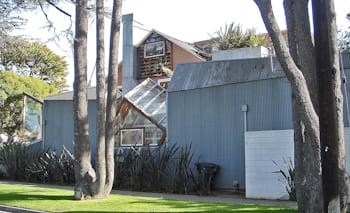
The Canadian-American Frank Gehry is one of the world's most influential architects. Having made a name initially for "Easy Edge" furniture constructed of corrugated cardboard and fiberboard, he built his reputation as an avant-garde architect after he rebuilt his own Californian home using hardware-store materials such as corrugated aluminum, unfinished plywood, and chain-link fencing. As MoMA writes, "The additive and collaged character of his house, based on semi-independent timber-frame structures, became the signature language of his 1980s work, which was presented in MoMA's 1988 Deconstructivist Architecture exhibition and in a retrospective of Gehry's work at the Whitney Museum of American Art that same year". As he experimented with contemporary forms, Gehry's designs grew increasingly fragmented and complex, blatantly defying expectations for contemporary architectural innovation (even among those working within the avant garde). After the MoMA and Whitney exhibitions, Gehry received several commissions for major public buildings that favored asymmetrical structures, twisted volumes, smooth textures, and modern technological features. This culminated with the opening of his "statement" buildings, the Guggenheim Museum, Bilbao (1991 - 97), and the Walt Disney Concert Hall, Los Angeles (1988 - 2003). Gehry's attention-grabbing structures are now considered architypes of the Deconstructivist style.
Deconstructivism into the 21st Century
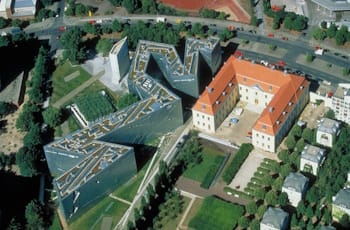
Hopkins writes, "Every avant-garde becomes mainstream after a while and though deconstructivism was in a sense architecture turned in on itself, external factors - economic and technological - would shape how it played out in 1990s and 2000s. [...] The work of Gehry, Koolhaas, Tschumi, and others in the 1980s and 1990s, inspired a generation of architects working in the Deconstructivist style in the 2000s". One of these was the Polish-American architect, Daniel Libeskind, whose Jewish Museum in Berlin opened in 2012. Hopkins says that his design "demonstrated how deconstructivism could invoke history, memory, and emotion in powerful and profound ways. Zigzagging across its site, the museum's design is partly iconographic - recalling an abstracted Star of David - and indexical too, with axes radiating out to addresses of Jewish families murdered in the Holocaust. With wound-like openings perforating its envelope, structure intersecting volumes and vice versa and vertical voids appearing unexpectedly, the building recasts our expectations of what architecture can be - and in doing so offers a haunting reflection on Jewish civilization and Nazi attempts to destroy it".
Although Deconstructivists generally rejected modernist orthodoxies, Owen Hopkins, writes that, "For young and aspiring architects looking for alternatives to modernism, but put off by postmodernism's perceived trivialities, constructivism was a revelation and it quickly became important in architecture schools, notably the Architecture Association in London under Alvin Boyarsky's direction [and] where several of the deconstructivist architects studied and taught in the late 1970s". One of its number was Zaha Hadid. Although already an established architect by the 1990s, the Iraqi-British Hadid's most renowned projects - such as her Guangzhou Opera House, China (2002-10), and Heydar Aliyev Centre in Baku, Azerbaijan (2007-12) - belonged to the new millennium. She is revered for her use of swooping, asymmetrical, and smooth forms that convey an organic essence that disguises her use of digital design technologies. Her buildings incorporate contemporary, unconventional, but harmonious forms into bustling metropolises worldwide. Of the major Deconstructivist architects, it is perhaps Hadid who received the most recognition for her ability to synthesize leading-edge technology and a deep respect for organic forms and integration into natural landscapes. Hadid is widely considered the most influential and successful female architects of all time.
Concepts and Styles
Constructivism/Deconstructivism
Deconstructivist architecture rejects the modernist edict that form (style) is always deferential to function (pragmatism). Rather, and in keeping with Derrida's rejection of binary oppositions (function over form) and ladders of hierarchies (modernism above classicism), Deconstructivists designed spaces in which function and form folded into one. However, while the Deconstructivists rejected the symmetrical lines of modernist architecture, they did draw early inspiration from the Soviet Constructivists (who themselves had drawn on aspects of Cubist and Futurist art). Constructivist architecture grew from the radical theories of pioneers such as Vladimir Tatlin, El Lissitzky, and Kazimir Malevich. Their ideas translated into architectural jargon as "stereometric forms" which, despite not insignificant stylistic differences, described an architectural blueprint purged of all decorative elements and all references to past styles. Emerging during the First World War, and on the cusp of the 1917 Revolution, the Constructivists challenged the laws of classical architecture and presented a utopian architectural vision for a new Socialist society (even if their radical sketches, designs, and models would never see the light of day).
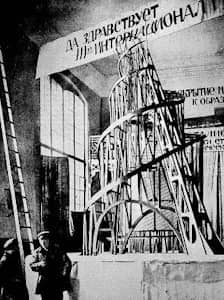
What seems at first like a Constructivist/Deconstructivist paradox (given the latter's general hostility towards modernism) was clarified by Stouhi. She writes that "[The Constructivists'] critical point of view and experimentation with forms disturbed the traditional perception of architecture and opened people's eyes to the endless possibilities of breaking architecture rules. Post war, Russia was undergoing radical changes and revolutions, and the impact of these revolutions on architecture was inevitable. Architecture was seen as a high form of art, influencing and being influenced by society, and so, social revolution = architecture revolution. Geometry, whether in art or architecture, became irregular. Vladimir Tatlin designed a bent monument trapped inside a twisted frame for the Third International in 1919. Aleksander Rodchenko presented an experimental design for a radio station that portrayed all sorts of geometric experimentation and irregularity".
Deconstructivist Sculpture
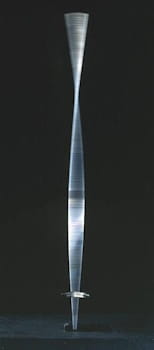
Of all the early 20th-century Russian sculptors it was perhaps Naum Gabo who maintained the closest ties to Constructivism's immediate predecessor, Suprematism. The earlier movement, led by Kazimir Malevich, was in pursuit of a "vanishing point" in art; a point where art became completely non-representational and existed purely to create, in Malevich's words, a "supremacy of feeling". Suprematism did not, then, support the idea that art should serve the cause of the Socialist Revolution. Gabo's abstract geometric sculptures used Constructivist materials such as glass, plastic, and metal but he, with his brother, Antoine Pevsner, authored the "Realistic Manifesto" (of Constructivism) in which they protested that Constructivist art should function independently of all state interests. Gabo maintained that art - if it was to be timeless - should be about energy, force, and rhythm. His Kinetic Composition (1920), for instance, featured a motor that rotated a steel blade and worked as a pure demonstration of relations between of space and time.
A century on, Daniel Libeskind unveiled his most high profile sculptural project, The Garden of Earthly Worries (2019) in the gardens of the 17th century Het Loo Palace in Apeldoorn, Netherlands. "Constructed" of modern industrial materials, Libeskind stated he wanted his four garishly colored, and "off-balance", abstract sculptures, "to conjure a sense of tension and movement". But, while he was evidently not working in the name of a "socialist cause", his sculptures' placing in the ordered natural beauty of the palace gardens (where they stayed for three years), while true to the aesthetic principles of Gabo, put them closer in philosophical outlook to Vladimir Tatlin's Constructivist tower (in that they carried an ideological message). As design critic Veronica Simpson described, "Libeskind has designed four fragments of an exploded globe, representing four greenhouse gases: carbon dioxide, methane, ozone and nitrous oxide. Constructed from panels of laser-cut, sheet metal, these slim, curving elements are tinted in appropriately noxious tones of green (CO2), yellow (ozone), blue (nitrogen) and red fading to black (methane), to represent the perilous point we have reached in man's exploitation of the earth's resources".
Asymmetry and Imbalance
Although they sought collectively to challenge and/or reinvent previous architectural styles, such is the lack of uniformity amongst Deconstructivists it is problematical to identify specific aesthetic signifiers within the movement. However, a consistent aspect of Deconstructivist buildings is a preference for imbalanced and asymmetric features that are sewn together in a way that creates a different type of cohesion and harmony. The architectural critic Janette Baumann asked: "Sloping walls, tilting rooms, structures seeming to collapse at any moment: deconstructivist buildings will inevitably catch your eye. But what is it about this type of architecture that makes us gasp?" Baumann was able to provide the answer to her own question: "Deconstructivist architects sought to fragment a construction and explore asymmetrical relations - while still maintaining the core function of a space. Architects began to manipulate surface structures, creating non-rectilinear shapes which seem dislocated at first glance. Their designs visualise a sense of 'controlled chaos': distorted walls and corners, skew lines, and ostensibly random arrangements are put together like collages".

The Beijing National Stadium was the centerpiece of the city's summer Olympic complex. The architects, Herzog and de Meuron, were charged with the task of creating "an urban site with the capacity to attract and generate public activities and to bring new life to this [northern] part of the city, even after the 2008 Olympic Games". The sports stadium was nicknamed the "Bird's Nest" as soon as the designs had been put on public display. From a distance, the arena's asymmetrical structure gives the impression of a massive whole, albeit one composed of irregular grid-like elements. But, as the architects themselves explained, "what is seen from afar as a geometrically clear-cut and rational overall configuration of lines evaporates the closer one comes, finally breaking away into huge separate components that look like a chaotic thicket of supports, beams and stairs. [...] The image of the stadium is, therefore, purely structural: facade and structure are identical. The load-bearing elements support one another and converge into a spatial grid-like formation in which facades, stairs, bowl structure and roof are integrated".
Voids: The Absent and the Present
One of the key concepts of Deconstructivism is a play on the intersection of lines and open and/or empty spaces - or "voids". Architectural voids fall into two main categories: cognitive and functional. The former relates to user perception and these are usually related to particular visual impressions; the latter meets the functional needs of the building in question. Furthermore, cognitive voids fall under three sub-headings: conceptual, perceptual/visual, and sculptural/monumental; functional voids divide into six: entrance, corner, balcony/terrace, gallery/atrium/courtyard, surface, and transition. Deconstructivist structures such as the Lois & Richard Rosenthal Center for Contemporary Art, in downtown Cincinnati, Ohio, which opened in 2003, meet both criterion at once. Designed by Zaha Hadid (it was in fact the first American museum to be designed by a woman) the street level façade features a wall of translucent glass that encourages pedestrians to observe the day-to-day "inner-workings" of a cultural institution. Hadid's aim was to help dismantle (or deconstruct) public perceptions of the fine art museum as an aloof and culturally exclusive space.
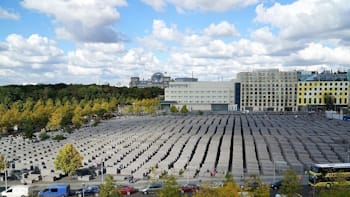
Working on a purely cognitive level, meanwhile, is Peter Eiseman's, Memorial to the Murdered Jews of Europe, Berlin (2005). The memorial, which features 2711 freestanding concrete stelae of different heights, across an expansive 19,000 square meters, uses voids (the spaces between each stelae) to allow for a wholly immersive experience whose function is to promote cognition and contemplation (it is supplemented by the underground information centre, also designed by Eisenman). The scale of the monument, its undulating floor, and the absence of any central point of remembrance, combine to upset all the conventions of war memorials to the point that the visitor might even experience feelings of disorientation. Historian Alexander McMillan writes, The Memorial to the Murdered Jews of Europe, "express[es] the importance of the void in order to achieve the decentering of the human subject, as it provides new forms of reference within architecture. [The] Memorial itself, and its lack of architectural signification [...] allows for open-ended interpretations and 'readings' of the space. [The monument] does not dictate any particular meaning or experience, raising new notions of our relationship to the Holocaust, and the intended purpose and use of memorial architecture".
Architectural Follies

The first known architectural follies date back to the 16th century, but reached the height of their popularity, especially amongst gentrified landowners in France and England, during the 18th and 19th centuries. Made of stone, wood, or brick, follies (in French, the term "folie" relates to a state of madness and/or extravagance; in English, an act of foolishness) were ornamental features for gardens, estates, and some public parks. Curator Emily Neuner writes, "Known for their variety, no architectural style or scale was off - limits, and included appearances of: Classical Greek and Roman temples; Gothic towers; Egyptian pyramids; Chinese pagodas [and] Rustic cottages". Neuner adds that many folly designers "loved the idea of ancient ruins, so they would construct 'sham ruins' - fake cottages, temples, or abbeys that, despite being brand new, appeared to be falling into disarray". Some other designers, meanwhile, "chose to model their follies off of fanciful structures that sprung from the imaginations of landscape painters, such as Claude Lorrain and Hubert Robert".
Adding to their ornamental function, follies tended to serve as hubs for social and/or ceremonial occasions, while some of the original folly towers doubled as hunting and lookout posts. For Deconstructivist architects the concept of follies transfers to a preference for extravagant ornamentation (where, as architectural critic Robert K. Lewis put it, "provocation prevails over clarification, imbalance over stability, and arbitrariness over rationality"). But these playful façades hide a collective commitment amongst the Deconstructivist architects to what might be called a "chaotic orderliness". As academic Ahmed Ibrahim explains, "Follies in [contemporary] architecture are buildings or parts of buildings constructed primarily for decoration [but are also] meant to act as points of reference that help visitors gain a sense of direction and navigate throughout the [architectural] space". This model was established early on by Bernard Tschumi (at the Deconstructivist Architecture exhibition) where his design for a new Parisian park, Parc de la Villette (1987), were of a more prosaic (less ornamental) function. His 35 "follies" took the shape of social hubs (including a concert hall, cinema, café, play area, and general vantage points) that also functioned as map markers for the park's expansive grid of interlocking pathways.
Later Developments - After Deconstructivism and Architecture
The Architectural Icon
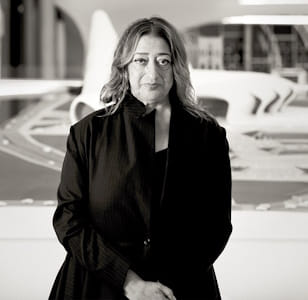
Hopkins writes that Frank Gehry's, Guggenheim Museum, Bilbao (1997), "launched the age of the architectural icon which saw cities and even nations realise the importance of architecture in shaping their image and improving their economic fortunes". He adds that in this respect, "deconstructivism's outlandish and by definition one of a kind forms, coupled to its association with globetrotting starchitects [...] was the gift that kept on giving". Indeed, in a rankings system devised by the architectural data team at The Massachusetts Institute of Technology (MIT) in 2023, it placed three Deconstructivists - Zaha Hadid (no.1), Frank Gehry (no.7) and Rem Koolhaas (no. 8) - in the top 10 (of 31) starchitects of the 20th and 21st centuries. Based on the individuals' number of "notable projects", and their accrual of awards (such as the top Pritzker prize), MIT's rankings helped set the value of a starchitect's brand to business and academia (namely their contribution to future learning), and help architectural and engineering firms "build and manage high-performing practices".
It is Gehry who, albeit inadvertently, gave rise to a phenomenon known as the "Bilbao effect". The architecture critic Rowan Moore has observed that, although not a wholly new idea, "Sydney, indeed, had demonstrated the value of the transformative landmark, as had Paris with the Pompidou Centre", cities such as "Frankfurt, Glasgow and Pittsburgh had [all] striven to raise themselves with culture and/or museum-building". However, what set Bilbao apart was "the degree of contrast between the city's lowly status and the artistic and architectural ambition of its proposed flagship". As Moore describes, "[Gehry's] convulsive, majestic, climactic [...] crossbreed of palazzo and ship that also flips its tail like a jumping fish [...] has given its name to the 'Bilbao effect' - a phenomenon whereby cultural investment plus showy architecture is supposed to equal economic uplift for cities down on their luck. It is the father of 'iconic' architecture, the prolific progenitor of countless odd-shaped buildings the world over. Yet rarely, if ever, have the myriad wannabe Bilbaos matched the original".
Parametricism
Technological advancements around the end of the 20th century saw Deconstructivist architects incorporate new software into their design practice. Parametric design, a method that uses an algorithm to complete components of building design, was first introduced in the 1990s but started to grow in influence in the 2000s. Patrick Schumacher's 2008 manifesto for Parametricism states: "Its most conspicuous outward characteristic is a complex and dynamic curvilinearity accentuated by a swarm-like proliferation of continuously differentiated components. Beyond such obvious surface features one can identify a series of new concepts and methods that are so different from the repertoire of both traditional and modern architecture that one is justified in speaking of the emergence of a new paradigm within architecture. The shared concepts, formal repertoires, tectonic logics and computational techniques that characterize this work are indeed engendering the formation of a new style".
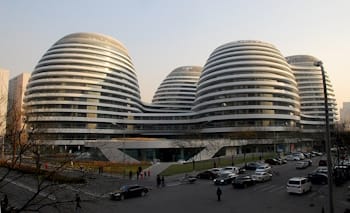
Figures such as Hadid and Frank Gehry turned to parametric practices, which better facilitated the use of repetitive (rather than "chaotic") motifs and curvilinear forms. Gehry's Walt Disney Concert Hall (2003) uses complex parametric features and saw Gehry's established 2-D "cutting-and-pasting" method combined with computer modelling to give the building its smooth irregular façade, and to maximize the acoustic clarity of the Concert Hall itself. Of Hadid's Galaxy Soho building in Beijing, meanwhile, architectural critic Rose Etherington writes, "[The Galaxy] comprises four main domed structures, fused together by bridges and platforms between curving floor plates to create a fluid environment that surrounds a series of public courtyards and a larger central 'canyon'. The design responds to the varied contextual relationships and dynamic conditions of Beijing". Hadid herself said of the design, "We have created a variety of public spaces that directly engage with the city, reinterpreting the traditional urban fabric and contemporary living patterns into a seamless urban landscape inspired by nature".
The Deconstructivism Controversy
The rise of Deconstructivism has not been welcomed by all within the architectural community. Its advocates defend Deconstructivism for the way it addressed the "inherent dilemmas" within modern architecture, while its critics have dismissed it as a distracting formal practice that provides little by way of lived social interconnection. This polarity of opinion was encapsulated by the writings of two prominent cultural/architectural theorists, Nikos A. Salingaros and Charles Jencks. Salingaros (who had dismissed Derrida's theory as "a virus") took issue with Jencks's use of mathematical concepts that fall under the umbrella term of "fractals‟ - those being complex, never-ending patterns created by repeating mathematical equations - to vindicate Deconstructivism's uneven formal extravagances. Salingaros (himself a doctor of mathematics) argued that Jencks's understanding of the concept of fractals was superficial at best and that Deconstructivism amounted in fact to no more that "a look" that had been "glamorized by clouds of fancy rhetoric" (espoused by the likes of Jencks).
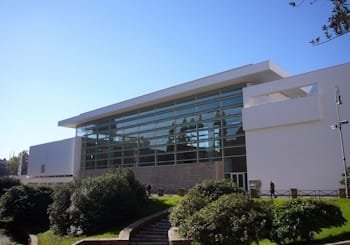
Indeed, Deconstructivism has done little to assuage the view that it merely continues to promote the "inherent dilemmas" of modern architecture in the way it upholds an architectural "establishment" marshalled by elitists and "starchitects". Historian Ray Sawhill encapsulates this predicament in his introduction to Salingaros's book, Anti-Architecture and Deconstruction (2010). He wrote: "Salingaros zeroes in on a recent real-life example - perfect in its scale and ironies - to crystallize his arguments: the Ara Pacis Museum in Rome, designed by the American uber-modernist and geometricist Richard Meier to house the remains of a 13 BCE altar memorializing the stability of the Roman Empire. [...] The contrast between life and death is complete. The angles, planes, voids, surfaces, and blinding light of Meier's work convey nothing more than the sterile chic of an expensive dentist's waiting room. Meanwhile, the exquisite small classical building it shelters and dwarfs is as vital as ever, and still radiates an intense life. Sadly, Meier's new Museum represents something all too emblematic of our time: an intrusion into the living soul of a great city by a jet-setting global elite peddling nothing more than their own conviction that they know best".
Useful Resources on Deconstructivism and Architecture
- The Architecture of Deconstruction: Derrida's HauntBy Mark Wigley
- Deconstrcutivist ArchitectureBy Philip Johnson and Mark Wigley
- Deconstructing Deconstructivist Architecture: A Study on the Mysterious 'Deconstruction' Architectural StyleBy Amit Murao
- Of GrammatologyBy Jacques Derrida
- On Deconstruction: Theory and Criticism after StructuralismBy Jonathan Culler
- Delirious New York: A Retroactive Manifesto for ManhattanBy Rem Koolhaas
- Peter Eisenman: Diagram DiariesBy Peter Eisenman
- S M L XLBy Rem Koolhaas, Bruce Mau, and Hans Werlemann
- Zaha Hadid. Compete Works 1970 TodayBy Philip Jodidio
- Tschumi Parc de la VilletteBy Bernard Tschumi
 Ask The Art Story AI
Ask The Art Story AI